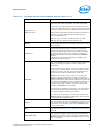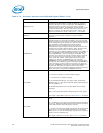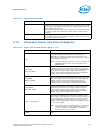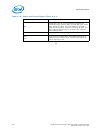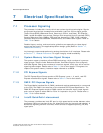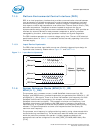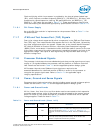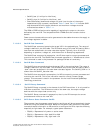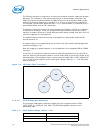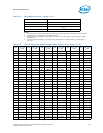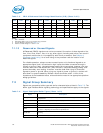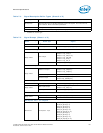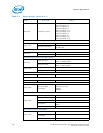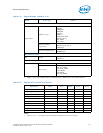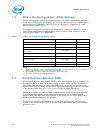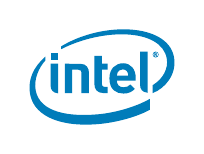
Intel® Xeon® Processor E5-1600 v2/E5-2600 v2 Product Families 131
Datasheet Volume One of Two
Electrical Specifications
• SetVID_fast (10 mV/µs for V
SA
/V
CCD
),
•SetVID_slow (2.5 mV/µs for V
SA
/V
CCD
), and
• Slew Rate Decay (downward voltage only and it’s a function of the output
capacitance’s time constant) commands.
Table 7-3 and Table 7-20 includes SVID
step sizes and DC shift ranges. Minimum and maximum voltages must be
maintained as shown in
Table 7-11.
The VRM or EVRD utilized must be capable of regulating its output to the value
defined by the new VID. The compatible VR12.0 PWM controller contains further
details.
Power source characteristics must be guaranteed to be stable whenever the supply to
the voltage regulator is stable.
7.1.9.3.2 SetVID Fast Command
The SetVID-fast command contains the target VID in the payload byte. The range of
voltage is defined in the VID table. The VR should ramp to the new VID setting with a
fast slew rate as defined in the slew rate data register. Typically 10 to 20 mV/µs
depending on platform, voltage rail, and the amount of decoupling capacitance.
The SetVID-fast command is preemptive, the VR interrupts its current processes and
moves to the new VID. The SetVID-fast command operates on 1 VR address at a time.
This command is used in the processor for package C6 fast exit and entry.
7.1.9.3.3 SetVID Slow Command
The SetVID-slow command contains the target VID in the payload byte. The range of
voltage is defined in the VID table. The VR should ramp to the new VID setting with a
“slow” slew rate as defined in the slow slew rate data register. The SetVID_Slow is 1/4
slower than the SetVID_fast slew rate.
The SetVID-slow command is preemptive, the VR interrupts its current processes and
moves to the new VID. This is the instruction used for normal P-state voltage
change. This command is used in the processor for the Intel Enhanced SpeedStep
Technology transitions.
7.1.9.3.4 SetVID Decay Command
The SetVID-Decay command is the slowest of the DVID transitions. It is only used for
VID down transitions. The VR does not control the slew rate, the output voltage
declines with the output load current only.
The SetVID- Decay command is preemptive, that is, the VR interrupts its current
processes and moves to the new VID.
7.1.9.3.5 SVID Power State Functions: SetPS
The processor has three power state functions and these will be set seamlessly via the
SVID bus using the SetPS command. Based on the power state command, the SetPS
commands sends information to VR controller to configure the VR to improve efficiency,
especially at light loads. For example, typical power states are:
• PS(00h): Represents full power or active mode
• PS(01h): Represents a light load 5A to 20A
• PS(02h): Represents a very light load <5A



